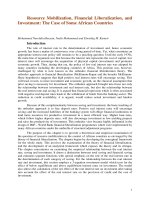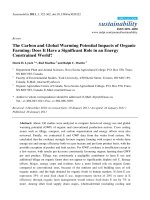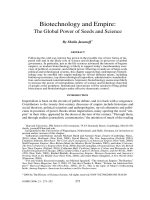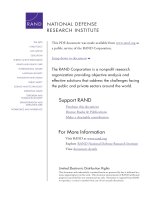high and mighty the dangerous rise of the suv
Bạn đang xem bản rút gọn của tài liệu. Xem và tải ngay bản đầy đủ của tài liệu tại đây (23.39 MB, 503 trang )
Praise
for
High
and
Mighty
"Bradsher
has a
wide range
of
contacts
in the
business
a
back-
ground giving weight
to
what easily could have become
a
polemic.
He
gives
a
comprehensive account
of how
lobbying
by car
companies,
car
dealers
and the
autoworkers' union blocked attempts
to
impose envi-
ronmental
and
safety
regulations
on
SUVs."
—The
Economist
"An
intelligent reader will conclude
from
this meticulous
and
sober
investigation that
the
makers
of
these behemoths have exploited
a
lucrative
market
of
self-regarding
urban
and
suburban consumers
who
care
not a
whit that
by
driving such menacing
and
wasteful
machines
they
are
committing
a
horrendously antisocial act."
—The
Atlantic
Monthly
"Detroit's
top
auto executives, plus legions
of
Explorer, Grand Chero-
kee, Durango, Navigator,
and
Tahoe owners, will
be
squirming—and
probably
fuming—over
publication
[of]
High
and
Mighty."
—Detroit
Free
Press
"Thoroughly
researched, superbly readable
A
tribute
to
what
one
hard-nosed
investigative
reporter
can
pull
off,
regardless
of
auto-
industry promotion
of an
alternate reality."
—Philadelphia
Inquirer
"Damned
if
Bradsher doesn't make
a
point.
In
fact
a
fusillade
of
points,
wounding enough
to get his
book banned
in
Michigan.
It
isn't
so
much that
the
average
SUVis
underengineered, inept,
unsafe,
pol-
luting,
fuel-guzzling
and
sociopathically aggressive
as
that it's
so
knowingly,
cynically, avoidably
so [A]
sobering, infuriating, neces-
sary
book."
—The
New
York
Times
Book Review
"Dazzling
Bradsher writes with knowledge
and
confidence.
His
book
is a
masterpiece
of its
kind, splendidly combining reporting,
analysis
and
indignation.
It
belongs
on the
same
shelf
as
Ralph Nader's
Unsafe
at Any
Speed
and Ida
Tarbell's
The
History
of
Standard
Oil, chroni-
cles
of the
dangerous interaction
of
corporate
perfidy
and
regulatory
breakdown.
High
and
Mighty
tells
us
more
than
we may
care
to
know
about
how
government malfunctions,
and
about
the
more disturbing
aspects
of the
American cult
of
driving—
Bradsher's
terrific book pro-
vides
incredible
and
ominous detail
on the
risks that
SUVs
and
pickups
pose
to
other
drivers,
and the
extent
to
which automakers knew
the
dangers
and
covered them
up."
—The
New
Republic
"This
is one of the
best books
on
American politics
I
have read
recently, although it's supposed
to be
about cars Marvelously
told
How
[the auto market] came undone
is
Keith Bradsher's men-
acing story,
and I
think
he has it
cold."
—The
New
York
Times
"It's
the
juicy background stories that make this
an
interesting
book—
It's
a
good read
that
is
packed with valuable information,
and
anyone
who
thinks they need
an
SUV—no
matter what
the
reason—
would
benefit
from
reading it."
—Motor
Age
"Superb
for
many reasons,
but
above
all
because
it
studies
the
rise
of
the SUV
from
inside
the
auto-industrial complex
itself
Fascinating
historical
material
is
presented with narrative panache Every
engaged citizen
of our
perishable
republic ought
to
read
this
book."
—Newsday
"Not
since Ralph Nader's
Unsafe
at Any
Speed
has
there been such
a
critical look
at the
U.S.
auto
industry,
or one
that
is
more timely."
—Seattle
Post-Intelligencer
"An
expose
in the
best tradition. Keith Bradsher takes
a
phenomenon
we all
think
we're
familiar
with—and then explains
its
hidden history
and
startling consequences
in
eye-opening ways. Anyone
who has an
SUV
in the
family
or who
faces
SUVs
on the
road will want
to
know
what's
in
this book."
—James
Fallows
"Reveals
not
just
the
get-the-profits-up-at-any-cost
excesses
of the
auto industry,
but the
craven behavior
of
Washington that surrenders
its
regulatory oversight,
the
true
safety
menace these truck pose,
and
even
the
cowardly silence
of
environmentalists.
Who
speaks
for
con-
sumers? This eloquent, painstakingly reported book does.
It is a
shout
that must
be
heard." —Ken
Auletta
"Bradsher
tells
the
gripping, sordid story
of the
domestic auto indus-
try's
callousness, cover-up,
deception,
and
greed—
A
siren
call
to
motorists
to
protect their
families,
pocketbooks,
and
environment,
and
buy
all-around better cars." —Ralph
Nader
MIGHTY
The
Dangerous
Rise
of the SUV
KEITH
BRADSHER
PublicAffairs
New
York
HIGH
Copyright
©
2002, 2003
by
Keith Bradsher.
All
rights reserved.
Published
in the
United States
by
PublicAffairs™,
a
member
of the
Perseus Books Group.
All
rights reserved.
Printed
in the
United States
of
America.
No
part
of
this book
may be
reproduced
in any
manner whatsoever
without
written
permission except
in the
case
of
brief
quotations embodied
in
critical articles
and
reviews.
For
information, address
PublicAffairs,
250
West 57
th
Street, Suite 1321,
New
York
NY
10107.
PublicAffairs
books
are
available
at
special discounts
for
bulk purchases
in
the
U.S.
by
corporations, institutions,
and
other
organizations.
For
more information,
please
contact
the
Special Markets Department
at the
Perseus Books Group,
11
Cambridge Center, Cambridge
MA
02142,
call
(617) 252-5298,
or
Book design
by
Mark McGarry,
Texas
Type
Book Works.
Set
in
Meridien
Library
of
Congress Cataloging-in-Publication data
Bradsher,
Keith.
High
and
mighty:
the
dangerous rise
of the SUV /
Keith Bradsher.—1st
ed.
p.
cm.
ISBN
1-58648-203-3
(pbk.)
1.
Sport utility vehicles—Crashworthiness.
2.
Consumer protection.
3.
Automobile industry
and
trade—United States.
I.
Title.
TL230.5.S66
B73
2002
629.2'31—dc21
20022028722
10
987654321
To
my
beloved
wife
and son
CONTENTS
Acknowledgments
ix
Introduction
xiii
PART
ONE
THE
BIRTH
OF THE SUV
1
Early Rumblings
3
2
Reviving
a
Corpse
18
3
Creating
the
Ford Explorer
43
4
Paving
the
Road
to
Ever Bigger
SUVs
61
5
The SUV
Economy
81
6
Reptile Dreams
93
PART
TWO
THE
DARK
SIDE
OF THE SUV
7 The
Myth
of
Four-Wheel-Drive
Safety
127
8
Rollovers
149
9
Kill
Rates
166
10 The SUV
Insurance Subsidy
207
viii
CONTENTS
11
Trouble
for
Cities
221
12
Global Warming, Gasoline Mileage,
and a
Gentlemen's Agreement
238
13
Seducing
the
Press
271
14 The
Green Prince
282
15
The
Ford Explorer-Firestone Tire Debacle
303
PART
THREE
THE
FUTURE
OF THE SUV
16 The
Next Drivers
of
SUVs
341
17
Crossover Utilities
352
18 The
Schwarzenegger Dividend
360
19 The
Triumph
of
SUVs
382
20
Finding
a Way Out 413
Epilogue
427
Myths
and
Realities
about
SUVs
443
The
Family
Tree
of
Automobiles
451
How to
Improve
Safety
in
Buying
or
Driving
an SUV 459
Notes
461
Index
475
ACKNOWLEDGMENTS
A
senior editor
of
business news
at The New
York
Times,
Glenn Kra-
mon, called
me
from
New
York
in
February 1997 with
an
intrigu-
ing
question.
As the
newspaper's Detroit bureau
chief,
I had
been
writing articles
for
more
than
a
year
that
mentioned
how
affluent
families
were
flocking
to
SUVs,
and how the
huge
profits
on
these
vehicles
were bringing renewed prosperity
to
Detroit.
But
Kramon
wanted
to
know about something that
had
little
to do
with busi-
ness: What happened
when
SUVs
hit
cars.
It
turned
out to be a big
problem that regulators
and
automakers were almost completely
ignoring.
With constant encouragement
from
Kramon,
I
wrote regularly
about
the
problems
of
SUVs
for the
next
four
and a
half
years.
In
between,
I did the
meat
and
potatoes
of
auto industry reporting:
writing about
the
management power struggles, marketing wars,
quarterly earnings
and
monthly sales
figures
of the
nation's
biggest
industry.
The
criticisms
of
SUVs
infuriated
auto executives,
who
denounced
me in
speeches
and in
interviews with other reporters.
x
ACKNOWLEDGMENTS
But The New
York
Times
consistently supported
my
coverage despite
the
criticism. Because
the
bulk
of my
articles
had
nothing
to do
with
SUVs
and a lot to do
with
subjects
near
to
every auto executive's
heart, like
who
would
be the
next
CEO of
Ford
or
General Motors,
the
industry's leaders
had to
keep talking
to me, and
they did.
The
backing
of The New
York
Times
was
also invaluable
to me in
tapping
into
the
knowledge
of
mid-level auto engineers.
The
news-
paper sent
me to
many auto engineering conferences,
where
I was
usually
the
only reporter
in
attendance.
I
found
the
engineers
spoke with remarkable candor,
as
engineers usually
do. In one of
my
favorite
"Dilbert" cartoons,
a
customer
refuses
to
listen
to a
marketing
employee
of the
company
and
demands
to
speak
to an
engineer, saying that engineers always speak
the
truth.
In the
car-
toon,
the
engineer bluntly tells
the
customer that
the
product
doesn't
work.
In
real
life,
engineers
say
that
SUVs
are
poor substi-
tutes
for
cars
when
it
comes
to
meeting
the
needs
of
most families.
This
book
is
essentially
a
biography
of the
sport utility vehicle.
Rather
than quote outside critics,
I
have tried
to
quote
the
auto
industry's
own
executives,
the men and
women
who
have
designed,
built
and
marketed
SUVs
despite their reservations about
the
vehicle's practicality
and
safety.
Some
of the
quotes were gath-
ered during interviews
for The
Times.
Others were gathered during
a
book leave that
The
Times
generously granted
me for
this
project,
a
leave
of
absence that allowed
me to
explore
the
history
and
prob-
lems
of
SUVs
in
much greater depth, gathering
a lot of new
infor-
mation.
A few
quotes
and
statistics
in
this book come
from
books
and
articles
by
other writers,
and
these sources
are
identified
in the
endnotes.
Rising
executives
in the
auto industry commonly change jobs
every year
or two
whereas
the
interviews
used
in
this book span
a
period
of six
years. Unless otherwise
specified,
all
quotes
in
this
book
are
attributed
to
officials
using
the
titles they held
at the
time
they made
the
comments.
ACKNOWLEDGMENTS
xi
My
literary agent, Freya Manston, helped
me
craft
the
initial
structure
of my
manuscript.
The
painstaking work
of my
editor,
Paul
Golob
of
PublicAffairs,
greatly improved
the
book.
I
very much appreciate
the
support
and
advice
I
have received
from
The
Times
and
especially
from
Glenn Kramon over
the
last
six
years.
But
this book
is
solely
my
project
and all of the
opinions
expressed
here
are my
own.
INTRODUCTION
Sport
utility vehicles have taken over America's roads during
the
last
decade,
and are on
their
way to
taking over
the
world's roads.
The
four-wheel-drive vehicles
offer
a
romantic vision
of
outdoor
adventure
to
deskbound baby boomers.
The
larger models provide
lots
of
room
for
families
and
their gear. Their size gives
them
an
image
of
safety.
The
popularity
of
SUVs
has
revived
the
economy
of
the
upper Midwest
and has
helped power
the
American economy
since
the
early 1990s.
Yet
the
proliferation
of
SUVs
has
created huge problems. Their
safe
image
is an
illusion. They roll over
too
easily, killing
and
injur-
ing
occupants
at an
alarming rate,
and
they
are
dangerous
to
other
road
users, inflicting catastrophic damage
to
cars
that
they
hit and
posing
a
lethal threat
to
pedestrians. Their "green" image
is
also
a
mirage, because they contribute
far
more
than
cars
to
smog
and
global
warming. Their gas-guzzling designs increase American
dependence
on
imported
oil at a
time
when
anti-American senti-
ment
is
prevalent
in the
Middle East.
xiv
INTRODUCTION
The
success
of
SUVs
comes partly
from
extremely cynical design
and
marketing decisions
by
automakers
and
partly
from
poorly
drafted
government regulations.
The
manufacturers' market
researchers have decided that millions
of
baby boomers want
an
adventurous image
and
care almost nothing about putting others
at
risk
to
achieve
it, so
they have told auto engineers
to
design vehicles
accordingly.
The
result
has
been unusually tall, menacing vehicles
like
the
Dodge Durango, with
its
grille resembling
a
jungle cat's
teeth
and its
flared fenders
that look like bulging muscles
in a
savage
jaw.
Automakers
are
able
to
produce behemoths that
guzzle
gas,
spew pollution
and
endanger their occupants
and
other motorists
because
of
loopholes
in
government regulations. When
the
United
States
imposed
safety,
environmental
and tax
rules
on
automobiles
in the
1970s, much tougher standards were
set for
cars
than
for
pickup trucks, vans
and the
off-road
vehicles
that
have since
evolved into sport utility vehicles. Many
of
these loopholes still
exist,
and
have spread
to
other countries
that
have copied Ameri-
can
regulations.
The
result
has
been
a
public policy disaster, with
automakers
given
an
enormous
and
unintended
incentive
to
shift
production away
from
cars
and
toward less
safe,
less
efficient,
more
polluting
SUVs.
No
automotive
safety
issue
has
ever captured
the
nation's atten-
tion with such intensity
as the
many rollover crashes
of
Ford
Explorer
sport utility vehicles equipped with Firestone tires that
failed.
Ford
and
Firestone have been rightly condemned
for
cutting
corners
in the
design
and
manufacturing
of the
Explorer
and the
tires,
and for
doing little
for
several years
as
some
of
their employ-
ees
learned
of
problems with
the
tires.
Yet
terrible
as the
tire-related crashes
have
been,
killing
as
many
as
300
people worldwide over
the
last decade, they
are
just
a
tiny
part
of the
safety
and
environmental problems associated with
sport utility vehicles. These problems
are
already needlessly killing
thousands
of
Americans each year. Hundreds
of
people
are
also
INTRODUCTION
xv
dying
unnecessarily
in
other countries that
are
starting
to use
large
numbers
of
SUVs.
The
height
and
width
of the
typical
SUV
make
it
hard
for car
drivers
behind
it to see the
road ahead, increasing
the
chance that
they will
be
unable
to
avoid
a
crash, especially
a
multi-vehicle
pileup.
The
stiff,
truck-like underbody
of an SUV
does little
to
absorb
the
force
of
collisions
with
trees
and
other roadside
objects.
Its
size increases
traffic
congestion, because
car
drivers
tend
to
give sport utility vehicles
a lot of
room,
so
fewer
vehicles
can get
through each green light
at an
intersection. Most
of the
nation's roadside guardrails were built
for
low-riding cars,
and
may
flip
an SUV on
impact instead
of
deflecting
it
safely
back
into
its
lane
of
traffic.
The
trucklike brakes
and
suspensions
of
SUVs
mean that their stopping distances
are
longer
than
for a
family
car,
making
it
less likely that
an SUV
driver will
be
able
to
stop
before
hitting
a
car.
And
when
SUVs
do hit
pedestrians, they
strike
them
high
on the
body,
inflicting
worse injuries
than
cars,
which have
low
bumpers that
flip
pedestrians onto
the
relatively
soft
hood.
For
all
their deadliness
to
other motorists,
SUVs
are no
safer
than cars
for
their
own
occupants. Indeed, they
are
less
safe.
The
occupant death rate
per
million
SUVs
is
actually
6
percent higher
than
the
occupant death rate
per
million cars.
The
biggest
SUVs,
which pose
the
greatest hazards
to
other
motorists, have
an 8
per-
cent higher death rate
for
their occupants than minivans
and the
larger
midsize cars like
the
Ford Taurus
and
Pontiac Grand Prix.
1
How is
this possible?
SUV
occupants simply
die
differently,
being
much more likely
than
car
occupants
to die in
rollovers,
as
well
as
being much more likely
to
send other drivers
to the
grave.
SUV
occupants also
face
a
higher risk
of
paralysis. While
no
national studies have been done, statewide studies
in
Arkansas
and
Utah
have
found
that rollovers account
for
nearly
half
of all
cases
of
paralysis.
Put
another way, rollovers cause almost
as
many para-
lyzing
spinal injuries
as all
illnesses,
falls
and
every other
form
of
xvi
INTRODUCTION
traffic
accident combined—even though rollovers make
up
less
than
1
percent
of all
crashes.
Worst
of
all,
we
have only seen
the
beginnings
of the SUV
prob-
lem, which
is
certain
to
become much bigger
and
much deadlier
in
the
years
to
come.
The
safety
hazards
of
SUVs
have been mitigated
until
now
because they have mainly attracted
the
safest
drivers
in
America.
The
principal buyers
of
SUVs
in the
1990s
and
early
2000s
have been baby boomers
in
their 40s, with some sales
to
people
in
their
30s and
50s. These
affluent
first
owners
of
SUVs
tend
to be the
most cautious drivers
on the
road, because they
are
mostly
middle-aged people
who
have plenty
of
driving experience
and
still have acute vision, hearing
and
mental
faculties.
Half
of
them also have
families,
so
they
are
much less likely
to be out
driv-
ing
in the wee
hours
of the
morning,
when
crash rates soar.
There
are 20
million
SUVs
on the
nation's
roads
and
more
than
half
of
them
are
less than
five
years old. Three-quarters
of the
full-
size
SUVs,
the
largest models,
are
also under
five
years old.
As
affluent,
cautious-driving baby boomers begin
to
sell their
SUVs
or
turn
them
in at the end of
leases,
the
used-vehicle market will
be
flooded
with these vehicles. Falling prices will make them more
attractive
to
younger drivers
and
drivers with poor
safety
records—
including
drunk drivers.
The
only thing more frightening
for
traffic
safety
experts
than
a bad
driver behind
the
wheel
of a new SUV is a
bad
driver behind
the
wheel
of an old
SUV
with
failing
brakes
and
other maintenance problems.
Traditional
SUVs,
which
use the
same underbodies
as
pickup
trucks,
have climbed
from
1.78 percent
of new
vehicles sold
in
1982
to 6.7
percent
in
1991
and
16.1 percent
in
1997,
and
have
since leveled
off at
about
17
percent.
The
change
has
been even
swifter
at the
luxury
end of the
auto market, with
SUVs
rising
from
less
than
one-twentieth
of the
market
in
1990
to
half
the
luxury
market
by
1996.
But
SUVs
still make
up
only
10
percent
of the
vehicles
currently registered
in the
United States. Most
of the
auto-
mobiles built
in the
1980s
are
still
on the
road,
and
these
are
INTRODUCTION
xvii
mostly
cars,
so
this
has
been holding down
the
percentage
of all
vehicles
on the
road
that
are
SUVs.
As
older
model
years
of
vehicles
are
scrapped, however, they
are
being replaced with
new
model
years
in
which
a
much larger proportion
of the
vehicles
are
SUVs.
This
will eventually make
SUVs
nearly twice
as
common
as
they
are
now.
SUVs
are a
problem
not
just
for
traffic safety
but for the
envi-
ronment. Because
of
their poor
gas
mileage, they emit
a lot of
car-
bon
dioxide,
a gas
linked
to
global warming.
A
midsize
SUV
puts
out
roughly
50
percent more carbon dioxide
per
mile
than
the
typi-
cal
car, while
a
full-size
SUVmay
emit twice
as
much.
The
Sierra
Club
likes
to
point
out
that driving
a
full-size
SUVfor a
year instead
of
a
midsize
car
burns
as
much extra energy
as
leaving
a
refrigera-
tor
door
open
for six
years.
SUVs
also spew
up to 5.5
times
as
much
smog-causing
gases
per
mile
as
cars.
Automakers made surprising progress
in the
1980s
and
1990s
in
improving
the
fuel
economy
of
cars,
but
these gains
are
being slowly
erased
by the rise of
SUVs.
Chrysler boasts that
its
full-size
Concorde
sedan
now has
better
acceleration
and
exactly
the
same
interior
room
as a
1978 Chrysler
New
Yorker luxury sedan,
but
gets nearly
the
same
gas
mileage
as a
1978 Dodge Omni subcompact,
23
miles
per
gallon.
Yet
sales
of the
Concorde
and
other large cars have
eroded,
displaced
by big
SUVs
like Chrysler's Dodge Durango—
which
get the
same mileage
as the
1978
New
Yorker, about
14
miles
to
the
gallon.
How
many people
is the SUV
boom already killing?
My
best
estimate
is
that
the
replacement
of
cars with
SUVs
is
currently
causing
close
to
3,000 needless deaths
a
year
in the
United States—
as
many people annually
as
died
in the
terrorist attacks
at the
World
Trade Center
in New
York
on
September
11,
2001. Roughly
1,000 extra deaths occur each year
in
SUVs
that roll over, com-
pared
to the
expected rollover death rate
if
these motorists
had
been driving cars. About 1,000 more people
die
each year
in
cars
hit by
SUVs
than
would occur
if the
cars
had
been
hit by
other cars.
xviii
INTRODUCTION
And
up to
1,000 additional people succumb each year
to
respira-
tory problems because
of the
extra smog caused
by
SUVs.
2
This
conservative estimate excludes
a lot of
problems that
are
hard
to
calculate, like
SUVs'
harm
to
pedestrians,
or
their contribu-
tion
to
global warming.
It
also excludes
the
growing problems over-
seas,
where
SUV
sales
are
also starting
to
rise, especially
in
Europe,
South America
and
Australia.
SUVs
are the
world's most dangerous vehicles because they repre-
sent
a new
model
of
personal transportation
that
is
inherently less
safe
for
road users
and
more
harmful
to the
environment than cars.
SUVs
also threaten
to
displace cars because
of a
phenomenon
known
as
"network
externalities."
This
economic concept holds that
if
enough people start using
a
certain product, everybody else will start buying
the
same product
just
for the
advantages
of
being able
to
work with people
who
already have
the
product. Consumers will
do
this even
if the
prod-
uct
chosen
is
technologically
inferior
to the
alternatives.
The
best example
of
network externalities lies
in the
computer
industry. Once enough people started using
Microsoft
DOS,
and
later
Microsoft
Windows,
then
practically everybody
had to use it,
even
though
Apple arguably
had a
much
better
product
in its
Mac-
intoshes.
Another good example
of
network externalities lies
in VHS
video recorders. They represent
a
less sophisticated technology
than
the
Beta machines with which they initially competed.
But
once enough people owned
VHS
video recorders, most movie
rentals became available
in a VHS
format
and
then
everybody
had
to buy VHS
machines.
SUVs
are
inferior
to
cars
in
safety,
pollution,
comfort
and
driving
performance.
Yet
their
sales
have
benefited
from
network
external-
ities.
It is
becoming harder
and
harder
to see
down
the
road while
sitting
in a
car, because
of the
impossibility
of
seeing through
the
INTRODUCTION
xix
tall
SUVs,
minivans
and
pickups ahead
in
traffic.
At
night,
the
glare
from
SUV
headlights
is
blinding
for car
drivers. Backing
a car out of
a
parking place between
two
taller vehicles
has
become
an
exercise
in
hope
that
no one is
about
to
come barreling
by. The
sheer size
and
menacing appearance
of
SUVs
inevitably make
car
owners
feel
less
safe.
The
result
has
been
a
highway arms race.
If
nothing
is
done
to
check this trend, automakers willgradually
make more
and
more people
feel
as
though cars
are
obsolete.
The
sale
of
SUVs
is
creating strong demand
for yet
more
SUVs,
as
Ford
Explorers
and
Toyota Sequoias displace Ford Tauruses
and
Toyota
Camrys
in
garage
after
garage. Advertising
reinforces
this trend.
The
auto industry completely
dwarfs
every other industry
in
adver-
tising,
accounting
for one in
every seven dollars
of
advertising
in
the
United States
and
bankrolling
the
nation's media
to a
remark-
able
extent,
especially
the
television
and
magazine industries.
The
auto industry outspends
on
advertising
the
next three largest
industries combined: financial services, telecommunications
(including
local, long-distance
and
cell phone service)
and
national
restaurant chains.
A big
chunk
of the
automakers'
ad
money
has
gone toward
ads
that subtly
or
blatantly undermine people's
confi-
dence
in
cars.
Picking
the
most
offensive
SUV ad is
hard, because there
are so
many candidates.
My
favorite
is the
nearly
full-page
newspaper
ad
that Cadillac
ran for its
huge Escalade
in
early 1999.
The
Escalade
was
photographed
from
a
point about
five
feet
in
front
and
about
two
feet
off
the
ground,
so
that
the
vehicle's huge grille looms over
the
viewer.
The
windshield above
is
entirely black, giving
no
hint
of
who
inside
is
bearing down
on the
viewer. Trees
are a
blur
of
motion around
the
sides
of the
vehicle
but the SUV
itself
is in
per-
fect
focus
as it
hurtles
forward.
It
looks just like what
you
might
see
in the
last second
of
your
life
as you
looked
out the
side window
of
your
car and
suddenly realized that
a big SUVhad
failed
to
stop
for
a
red
light.
The
text
of the ad is
even more
frightening.
"YIELD,"
it
com-
xx
INTRODUCTION
mands
at the
top,
in
inch-high, underlined letters.
In
half-inch let-
ters
under
the
Escalade
is
another warning, delivered
in
parenthe-
ses:
"(Please Move Immediately
To The
Right)"
The
large type text
below continues
in the
same
tone:
"You might
as
well give
in
now.
Because
this
is the new
Cadillac Escalade.
The one
luxury
SUV so
powerfully
built
and
intelligently equipped,
it's
designed
to be,
well, irresistible. With
the
standard go-everywhere support
of the
OnStar
system, Escalade brings
you
virtually unlimited personal
concierge
services, emergency assistance
and
directions, right
at
your fingertips.
And no
other
SUV in the
world
can
make that
claim.
So
tell
the
other
luxury
SUVs
to
yield
the
right
of
way.
Because
Escalade
is
coming through."
Underneath
was the
Escalade slogan,
in
white lettering against
a
solid
black box. "Escalade:
It's
Good
To Be The
Cadillac."
You
might
be
more likely
to
survive
if you
were
in the
Cadillac
in
the ad
than
in
whatever lower-riding
car it was
about
to
hit.
But
few
people reading
the ad
carefully
could possibly conclude
that
"to
be the
Cadillac"
was
"good"
in a
moral sense.
Nor is it
good
for
public
safety
and the
environment
to
have even some people
"be
the
Cadillac"
in the
sense
of
this
ad.
The
ad's
advice
for
other drivers
to
yield
is
actually pretty good
advice,
however,
as the
Escalade
can be a
hard vehicle
to
control
even
for an
experienced driver.
The
steering
is
sluggish,
the
suspen-
sion vague
and the
brakes
not as
effective
as car
brakes.
I
climbed
in one of the
early Escalades
in
early 1999
at
Detroit's airport
for a
test drive,
but was so
appalled
by its
unresponsive steering
that
I
drove straight
home.
I
called
Cadillac
and
asked
them
to
pick
up
the
vehicle
and
take
it
away. Cadillac
has
improved
the
Escalade
somewhat since
I
first
drove
it, but it
still
has the
nimbleness
and
ride quality
of a pig on
stilts.
While
the
Escalade's sheer bulk
may
provide some protection
in
collisions
with
cars, that does
not
mean
it is
especially well
designed
for
safety
in
other crashes. Regulators give
it a
so-so
three-star rating
(on a
scale
of one to
five)
for
driver survival
in a
INTRODUCTION
xxi
frontal
crash
with
another vehicle
of the
same weight
or
with
a
solid
object, like
a
bridge abutment. Many large cars
and
minivans
now
carry
five-star
ratings
and the
rest typically
earn
four
stars.
The
regulators also took
the
extremely rare step
of
noting
that
while thigh injuries
are not
included
in
calculating survival odds,
Escalade
drivers
are at
unusually high risk
of a
fractured
femur
in a
serious
frontal
crash.
Cadillac,
a
division
of
General Motors, rushed
the
Escalade onto
the
market
in
1998,
a
little over
a
year
after
the
Lincoln Navigator
went
on
sale
and was an
instant hit.
To
make
the
Escalade,
GM
essentially
put
lots
of
chrome
and
optional equipment
on a GMC
Yukon
SUV,
which
in
turn
is
little more than
a
fancy
version
of a
Chevrolet
Tahoe SUV.
The
Tahoe,
in
turn, uses
the
underbody
and
a lot of
other parts
from
the
full-size
Chevrolet Silverado pickup
truck.
So
Cadillac
was
essentially taking
a
$20,000 work truck,
tricking
it up
with lots
of
chrome, leather seats,
and a
fancy
stereo,
and
selling
it for
close
to
$50,000. This
is how
automakers have
earned enormous
profits
on
full-sized
SUVs.
GM and
Ford have
nearly seven times
the
sales
of
Microsoft,
and
each
has
been
restored
to
financial
health
by SUV
profits.
GM
has
been
the
most aggressive automaker over
the
last sev-
eral years
in
stepping
up
sales
of
large, pickup-based
SUVs.
GM
executives like
to
defend
their decision
to
make vehicles like
the
Escalade
by
saying
that
they
are
simply building
what
Americans
want.
As
long
as
gasoline prices remain low, government regula-
tions remain tilted against cars,
and
Americans remain enamored
of
big, macho vehicles worthy
of the
American
frontier,
executives
at GM and
other automakers plan
to go on
making
SUVs.
Harry
Pearce,
the
powerful
vice chairman
of GM, put it
best
as
he was
leaving
a
press conference
in
August 2000:
"If
pigs
are big
and
popular,
I
guess we'll make pigs."
PART
ONE
THE
BIRTH
OF THE SUV
EARLY
RUMBLINGS
At
Henry Ford's mansion outside Detroit,
the
carved wood busts
supporting
the
ceiling
in the
ballroom show
the
inventor
of the
Model
T and
three close
friends,
all
famous:
Harvey Firestone,
founder
of the
tire company
that
bears
his
name;
Thomas Edison,
inventor
of the
lightbulb
and
phonograph;
and
John
Burroughs,
the
naturalist.
The
four
men
loved
to go on
camping trips
in the
1920s, accompanied
by
cooks
and
other
servants
in
Ford's employ.
Driving
automobiles specially made
in
Ford
factories,
they would
spend weeks
at a
time traversing
the
American West; they called
themselves
the
Vagabonds.
The
mansion, Fairlane,
is now a
museum, preserved much
as it
was
in
Henry Ford's day,
and its
large octagonal garage
is
what
you
might expect
of an
auto baron—or perhaps
a
railroad magnate,
since
the
garage looks
a
little like
an old
railway roundhouse
for
steam engines. There
are
huge windows around
the
circumference,
so
that
Henry Ford's automobiles
can be
admired
in
natural
light-
ing. There
is a
turntable
in the
middle,
to
make
it
easier
to put
each
car
into
its
space against
the
walls.
1
4
HIGH
AND
MIGHTY
Next
to the
door
is a
1922 Lincoln camper that
was
custom
made
for the
Vagabonds' trips.
The
Ford
Motor
Company
put
this
vehicle
on
display
at the
Detroit auto show
in
1997
when
it
unveiled
the
Lincoln Navigator
full-sized
SUV, contending
that
Henry
Ford
had
created
the
first
sport utility vehicle.
But the
camper looks nothing like
any SUV
today. There
are no
seats
behind
the
front
row, just
a
long, enclosed cargo area
in the
back
for
carrying camping gear.
It is
basically
a
pickup truck with
a
cov-
ered bed.
What
is an
SUV?
There
is no
official
definition—most govern-
ment regulations simply have categories
for
"off-highway
vehicles,"
which
in
turn
are
lumped
in
with pickup trucks
and
minivans
as
"light
trucks."
The
auto industry
has not
settled
on a
definition
either.
My
definition
has
five
parts.
An SUV is a
vehicle
that
(1) has
four-wheel
drive available
as
either standard
or
optional equip-
ment;
(2) has an
enclosed rear cargo area like
a
minivan;
(3) has
high ground clearance
for
off-road
travel;
(4)
uses
a
pickup-truck
underbody;
(5) is
designed primarily
for
urban consumers
and
marketed primarily
to
them,
with
a
cushy
suspension
and
other
features
that
may
even compromise some
of its
appeal
to
serious
off-road
drivers.
In the
last
few
years, automakers have begun tak-
ing car
designs
and
making them considerably taller
and
adding
four-wheel
drive,
so as to
market
the
result
as an
SUV. These vehi-
cles, like
the
Toyota Highlander,
which
is
derived
from
the
Camry
sedan,
are
often
described
within
the
auto industry
as
crossover
utility vehicles,
not
SUVs,
because they
are not
based
on
truck
underbodies.
I
follow
this convention
in
this book.
General Motors contends that
the
Chevrolet Suburban, which
was
introduced
in
1935,
is the
world's oldest sport utility
in
mass
production.
The
Suburban also happens
to be the
oldest nameplate
of
any
car, minivan,
SUVor
pickup truck
in
continuous production
in the
United States.
The
early Suburban
was a
handsome vehicle,
a big
powerful
automobile
of the
sort
that
Al
Capone might have been proud
to
EARLY
RUMBLINGS
5
drive.
It had a
long hood with
a
tall grille
on the
front,
and
then
a
long, elegant passenger compartment with three windows
on
each
side
and two
more
in the
back door.
To
make
the
Suburban, Chevrolet engineers simply used
the
hood,
engine,
fenders
and
underbody
of a
pickup truck
and
fash-
ioned
an
attractive passenger compartment
to
replace
the
pickup
truck
cab and
bed.
No one at GM can
identify
the
father
of the
Sub-
urban. Chevrolet
officials
say
that
the
first
Suburban
was
probably
a
minor project, viewed
as a
variation
of an
existing pickup truck
design,
and so its
development
did not
merit
any
mention
in the
files
that survive
from
that era.
The
name "Suburban"
was not
orig-
inal
either—another
GM
division,
Cadillac,
had
sold
an
expensively
upholstered, seven-passenger Suburban
sedan
from
1918
to
1927.
A
1936 Chevrolet truck catalog touted
a
"Carryall Suburban"
available
as
either
a
passenger vehicle
or as a
light delivery truck,
with side windows
filled
in
behind
the
front
row of
seats.
A
photo
of
the
passenger version showed
a
fashionably dressed woman
stepping
out of a
Suburban while
a
liveried
chauffeur
holds
the
door. "Its utility
is
proved
by its
wide demand
by
private estates,
country clubs, hotels,
bus and
transfer companies, airports,
as
well
as
operators
who use it for
business
and
pleasure,"
the
catalog said.
1
But
until
the
1960s, Chevrolet only sold
the
Suburban with
one
door
on
each side,
a
design that reflected
the
pickup truck model
on
which
it was
based. That made
it
hard
to
climb into
the
rear
seats,
and
limited
the
demand
for it as a
family
vehicle. What kept
the
Suburban
in
production
for so
many years
was the
delivery
truck
version, which
was
especially popular
in one
specialized mar-
ket:
funeral
homes.
Undertakers discovered
that
with
all but the
front seats
removed,
the
back
of a
Suburban
was
precisely
the
right length
and
height
for
carrying
the
dead, either
in
bags
or in
coffins.
Suburbans
were used
as
"first-call"
vehicles
to
pick
up the
dearly departed
at
homes
and
hospitals
and
bring them back
for
burial preparations,
while converted limousines were preferred
as
hearses
for
funeral









